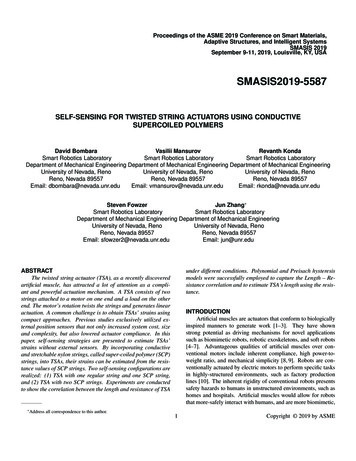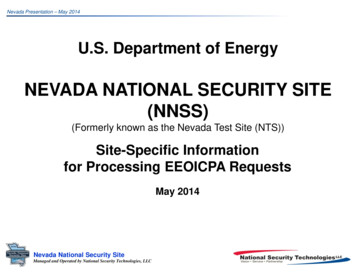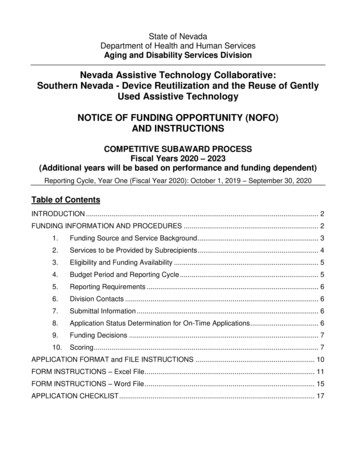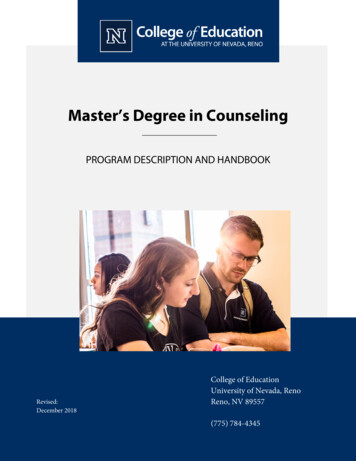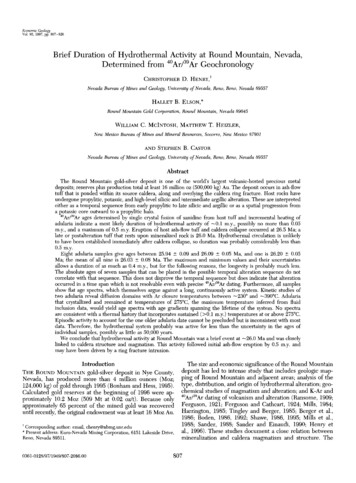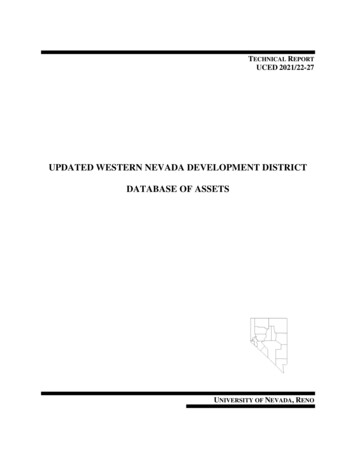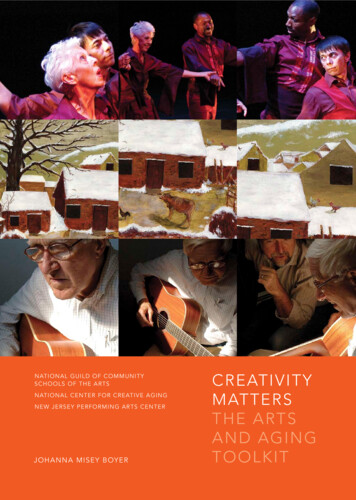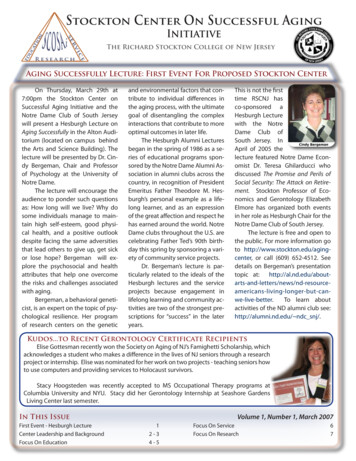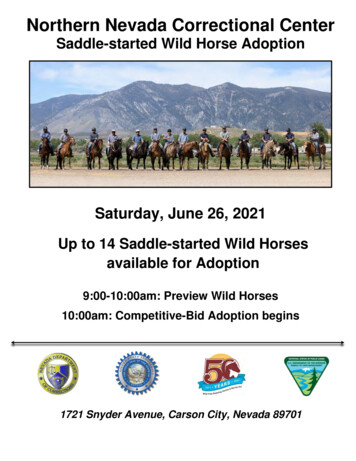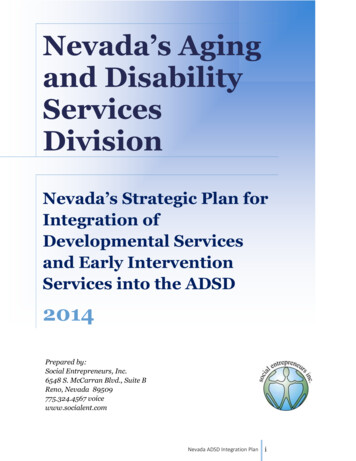
Transcription
Nevada’s Agingand DisabilityServicesDivisionNevada’s Strategic Plan forIntegration ofDevelopmental Servicesand Early InterventionServices into the ADSD2014Prepared by:Social Entrepreneurs, Inc.6548 S. McCarran Blvd., Suite BReno, Nevada 89509775.324.4567 voicewww.socialent.comNevada ADSD Integration Plani
TABLE OF CONTENTSGLOSSARY . 5INTRODUCTION & PURPOSE OF THE PLAN . 8SYSTEMS DESCRIPTION . 11ORGANIZATIONAL STRUCTURE . 16VISION AND PLANNING PRINCIPLES. 18SITUATIONAL ANALYSIS. 19KEY NEEDS OF NEVADANS THAT ADSD SHOULD ADDRESS. 20HOW THE SERVICE DELIVERY SYSTEM WORKS .22STRATEGIC OPPORTUNITIES THAT INTEGRATION OFFERS .26CRITICAL ISSUES TO BE ADDRESSED THROUGH INTEGRATION. 27CRITICAL INTEGRATION ISSUES .31GOALS AND OBJECTIVES . 32FUTURE VIEW – A FIVE YEAR MAP TO LIFESPAN SERVICES . 33INTEGRATION PLAN . 37PROVISIONS FOR UPDATING THE PLAN. 52GAPS IN SERVICES ACROSS THE LIFESPAN . 52APPENDIX A STAFF AND PROVIDER OUTREACH SUMMARY INTRODUCTION. 53AGING AND DISABILITY SERVICES DIVISION INTEGRATION EFFORTS . 53PURPOSE OF STAFF AND PROVIDER SURVEYS . 53METHODS . 54SURVEY RESPONDENTS PROFILE . 54RESPONDENT SELF-IDENTIFICATION . 54SNevada ADSD Integration Planii
PROGRAM REPRESENTATION. 55RESPONDENT LENGTH OF SERVICE IN THE FIELD . 56RESPONDENT AGE . 56GEOGRAPHICAL REPRESENTATION . 57FINDINGS . 58CRITICAL ISSUES .58GOALS .62ACTIVITIES . 65STAFF AND PROVIDER INPUT . 68CONCLUSION . 70SNevada ADSD Integration Planiii
ACKNOWLEDGEMENTSThis plan is possible because of individuals across the state that work to ensure that Nevadans,regardless of age or ability, will enjoy a meaningful life led with dignity and self-determination.They include families, advocates, health care professionals, and providers at businesses andorganizations that serve residents throughout the state.Leadership for this plan came from Nevada’s Aging and Disability Services Division. The plan wasdeveloped by a Steering Committee that dedicated countless hours to ensure the integration issuccessful.Hundreds of participants helped to shape this plan by completing surveys, participating in keyinformant interviews and attending meetings. Their assistance is gratefully acknowledged.Strategic Planning Advisory TeamMichele FerrallNevada Aging and Disability Services DivisionTina Gerber-WinnNevada Aging and Disability Services DivisionJane GrunerNevada Aging and Disability Services DivisionJulie KotchevarNevada Aging and Disability Services Division, Disability ServicesConnie McMullenCommission on AgingRosemary MelarkeyNevada Aging and Disability Services Division, DevelopmentalServicesBrian PatchettEaster Seals NevadaSue RhodesClark County Social ServicesKaren TaycherNevada PEPThis plan was developed through consultation with Social Entrepreneurs Inc. (SEI)6548 South McCarran Blvd. Suite BTel. 775.324.4567Reno, NV 89703www.socialent.comNevada ADSD Integration Planiv
GLOSSARYAging and Disability Resource Centers (ADRC) – Aging and Disability Resource Centers have been funded inNevada to create a single, coordinated system of information and access for all persons seeking long-termsupport to minimize confusion, enhance individual choice, and support informed decision-making.Age in Place - Older adults and people who have disabilities want to live as independently as possible for aslong as possible in their homes and communities.Elder Abuse - A single or repeated act or lack of appropriate action, occurring within any relationship wherethere is an expectation of trust, which causes harm or distress to an older person.Family-Centered - Family-centered practice is a way of working with families, both formally and informally,across service systems to enhance their capacity to care for and protect their children. It focuses on needswithin the context of their families and communities and builds on families' strengths to achieve optimaloutcomes. Families are defined broadly to include birth, blended, kinship, and foster and adoptive families.1Family Resource Center (FRC) – The State of Nevada defines a family resource center as “a facility within anat-risk neighborhood where families who reside within that neighborhood or a contiguous at-riskneighborhood may obtain: 1. An assessment of their eligibility for social services, 2. Social Services; and 3.Referrals to obtain social services from other social service agencies or organizations.” Family ResourceCenters emphasize community based, resident driven, collaborative programs that are culturally competent,accessible and flexible.Fidelity – Fidelity is defined as the extent to which delivery of an intervention adheres to the protocol orprogram model originally developed2.Frontier Areas – Frontier areas are sparsely populated rural areas that are isolated from population centersand services. Frontier is defined as places having a population density of six or fewer people per square mile.Home and Community Based Services (HCBS) – A wide array of home and community based services that anindividual may need to avoid institutionalization such as case management, homemaker, home health aide,personal care, adult day health care, habilitation, respite care and other services.Housing and Urban Development (HUD) – A federal agency that provides and funds a variety of housingprograms including affordable housing.Livable Community - A community that has appropriate housing at a price people can afford. It is builtaround green spaces and has places to shop, socialize and play nearby. Residents know where to find thelocal library, health services, schools and other community facilities. Many of these are within walking orcycling distance, and form a core for the community. Good transit provides connections to otherdestinations outside the community.12US Department of Health and Human Services, Administration for Children and Families.Mowbray, C.T., Holter, M.C., Teague, G.B., & Bybee, D. (2003). Fidelity criteria: Development, measurement,and validation. American Journal of Evaluation, 24, 315-340.Nevada ADSD Integration Plan5
Long-Term Care (LTC) - LTC describes a number of different scenarios, all of which include providing acontinuum of services that may include medical care, housing, social services, recreation, and other servicesto persons with disabilities or chronic care needs. These include a continuum of options including in-homecare, senior apartments, assisted living facilities nursing homes and many other settings.Memorandum of Understanding (MOU) - A legal document outlining the terms and details of an agreementbetween parties, including each party’s requirements and responsibilities.Management Information System (MIS) - An information system that integrates data from all thedepartments it serves and provides operations and management with the information they require.Person-centered – Person-centered practice is defined as treatment and care that places the person at thecenter of their own care and considers first and foremost the needs of the person receiving the care. It isalso known as person-centered care, patient-centered care and client-centered care. Person-centeredpractice is treating persons/patients/clients, as they want to be treated3.Poverty - The state of being poor; lack of the means of providing material needs or comforts. Usually definedby state and federal agencies.No Wrong Door - A no wrong door approach provides people with, or links them to, appropriate serviceregardless of where they enter the system of care. Services must be accessible from multiple points of entryand be perceived as welcoming, caring and accepting by the consumer. This principle commits all services torespond to the individual’s stated and assessed needs through either direct service or linkage to appropriateprograms, as opposed to sending a person from one agency (or department) to another4.Respite Care – Respite care is the short-term supervision or care and time-limited breaks for families of adependent elderly, ill, or individual with a disability, children with a developmental delay, and adults with anintellectual disability or related condition. Respite care services are designed to offer families/caregivers theopportunity for a break from care giving responsibilities.Rural Area -- U.S. Census defines rural as: Territory, population and housing units not classified as urban."Rural" classification cuts across other hierarchies and can be in metropolitan or non-metropolitan areas.Safety net services – Safety net is defined as community provided welfare services at local and state levelgeared towards reducing poverty in the community. It can include housing, jobs and money for utility billsand food or food coupons.Self-Determination – A characteristic of a person that leads them to make choices and decisions based ontheir own preferences and interests, to monitor and regulate their own actions and to be goal-oriented andself-directing.5Definition adapted from retrieval on November 11, 2013 ng%20Person%20centred%20practice.pdf4 Retrieved on November 11, 2013 from: http://www.nowrongdoor.org.au/policy procedures.html5 Retrieved on January 23, 2014 from: on3SNevada ADSD Integration Plan6
Self Neglect - Self neglect refers to situations in which there is no perpetrator and neglect is the result of theperson refusing care and/or being unable to care for themselves.Seniors - A person 60 years of age, of relatively advanced age, especially a person at or over the age ofretirement.Standards of Service Delivery – Service delivery standards are a set of clear and public criteria with explicitindicators that define service delivery performance that can be monitored and reviewed6.System of Care – The system of care model is an organizational philosophy and framework that involvescollaboration across agencies, families, and youth for the purpose of improving services and access andexpanding the array of coordinated community-based, culturally and linguistically competent services andsupports7.Universal Design –An approach to the design of products, services and environments to be usable by asmany people as possible regardless of age, ability or situation.Urban Area - Urban areas are defined as both urban clusters (2,500 people but fewer than 50,000) andurbanized areas (population density of at least 1,000 people per square mile of land area that together havea minimum residential population of at least 50,000 people.)Walkable Community - A community in which pedestrians have safe places to walk that take them to theplaces they want to travel on foot (or via wheelchair). A walkable community has made a conscious effort toafford pedestrians an equal status with motorists and other road users and to encourage more people towalk. It is measured by public perceptions about the importance of walking in the community and about thefeasibility of walking as a mode of transportation.Retrieved on November 11, 2013 rviceDeliveryStandardsf.pdf7 Retrieved on November 11, 2013 from: vada ADSD Integration Plan7
INTRODUCTION & PURPOSE OF THE PLANDIVISION DESCRIPTION AND PLANNING NEEDThe Aging and Disability Services Division (ADSD) represents Nevadans who are aged or have a disability,regardless of age, and assists the broader community that touches their lives. Through advocacy,counseling and a broad array of supportive services, ADSD strives to create an environment thatenables all of the Nevadans they serve to be self-sufficient, independent and safe.In 1971 the Nevada State Legislature established the Division for Aging Services, now ADSD. Since itsinception more than 40 years ago, ADSD has been the primary state agency working on behalf of Nevada’selders by developing, implementing and coordinating programs for seniors throughout the state. In 2009,ADSD’s mission was expanded to include persons with disabilities.In the 2013 Nevada Legislature, Assembly Bill (AB) 488 took integration a step further by transferringDevelopmental Services (DS) and Nevada Early Intervention Services (NEIS) to ADSD. Formerly DS washoused within Mental Health and Developmental Services (MHDS) and NEIS was housed within the HealthDivision. (Since then, Health and MHDS have also merged to become the Division of Public and BehavioralHealth.)The benefits of integrating the services include a better ability to: Promote community living for Nevadanswith disabilities of all ages (across thelifespan)Create and enhance strategies toensure the necessary services andsupportsProvide a responsive and effectiveservice system that acknowledgesunique needsFirmly establish no wrong door forservicesExpand outreach efforts Promote seamless service deliveryincluding transitions across programs toobtain the full spectrum of care andbetter service coordination forparticipants with similar needsImprove access to information oncommunity services and supports suchas housing, employment, education,social participation, etc.Create a similar comprehensivecommunity provider application andoversight processStrengthen basic infrastructure such asinformation technology (IT), fiscal andaccountabilityNevada ADSD Integration Plan8
THE BACKDROP: NEVADA’S SENIORS AND PERSONS WITH DISABILITIESAs noted in a January 2012 Legislative Counsel Bureau Research Brief, Nevada has been one of the fastestgrowing states in the United States for the last 20 years, increasing in total population from 1,201,833 in 1990to 2,700,551 in 2010. It was also the fourth consecutive decade in which Nevada was the country’s fastestgrowing state and had a population growth rate over 50%. The two major age groups, which grew at a fasterrate than the general population, are children, representing 24.6 % of the total population, and senior adults,ages 65 or older, at 12 % of the total State population.8It was estimated in 2012 that Nevada’s population was 2,758,931. Of that population, it is estimated that 12.5%are age 65 or older.9 The percentage of non-institutionalized, male or female, all ages, all races, regardless ofethnicity, with all education levels in Nevada that reported a disability in 2011 was 11.4%. This includes childrenages three and under with a reported disability.In Nevada, there are approximately 195,000 children under the age of 4 and another 565,000 between theages of 5 and 19. Studies conducted by the American Pediatric Association have indicated thatapproximately 13% of children under the age of 3 have a developmental delay. In Nevada, this would create apotential pool of 25,350 children who may have a developmental delay. The ability to serve these children ismeasured by a factor called the penetration rate. Nevada’s penetration rate is 1.3 % of the total population. Incomparison, the national average penetration rate is 2.79% of young children with an individual family serviceplan (IFSP). In addition, Nevadans age 65 and older who report a disability is estimated at 34.5% of thepopulation.10 When comparing the number of people estimated to have a developmental delay compared tothose served (or the penetration rate of services) a state of the state’s report estimates that Nevada serves16% of those in need compared to the national average of 31%.11 To meet the national average, Nevada wouldhave to serve an additional 15% or 6,417 persons.All Nevadans have experienced challenges in receiving services in the past five years due to the economicrecession and its impact on Nevada. Increased demand on services is due to high unemployment, housingforeclosures, Nevada’s budget challenges and issues such as in-migration of retirees, aging of the existingpopulation, and the out-migration of younger people – especially from rural communities.Overwhelmingly, Nevadans want to live their lives in their own communities. Nationally, four out of fiveolder individuals prefer home care when they need help. Enabling children to achieve their optimaldevelopment, adults to live in the setting of their choice, and seniors to age in place requires a significantcommitment to ensuring that resources and community-based services are available, accessible and providequality care. The integration plan is designed to achieve those objectives by effectively bringing NEIS and DSinto ADSD and aligning service delivery strategies. The plan will:Research Division, Legislative Counsel Bureau Policy and Program Report, January 2012Retrieved from http://quickfacts.census.gov/qfd/states/32000.html on April 20, 2013.10 Retrieved from m?statistic 1 on April 20, 2013, maintained byCornell University.11 Retrieved from df on January 24, 2014.89Nevada ADSD Integration Plan9
Create a functional team representing NEIS, DS, and Aging and Disability Services that canidentify and resolve integration issues while communicating to the staff and public;Define the path and process to integrate NEIS and DS into Aging and Disability Services in amanner that provides high quality services that meet the community’s needs while responding topolicy, compliance, and legal mandates; andOptimize funding and service delivery opportunities.As previously noted, there are a number of strengths that can be built upon in the planning process. One isthat NEIS, DS, and Aging and Disability Services have a similar service delivery mode that focuses on highquality, community-based services that are person directed and that provide personal choice. At the sametime, the merger of these programs will allow consolidation of effort in areas such as staff training, grantwriting, quality assurance, provider development and contract monitoring. It will also reduce duplication ofservices, align expectations and provide a seamless transition from one service to another.SNevada ADSD Integration Plan10
SYSTEMS DESCRIPTIONThe service delivery system within Nevada has changed considerably over the past decade and more.Changes reflect Nevada’s population growth, new federal regulations and legislation enacted within thestate to better serve Nevadans. This section describes the system prior to and following the merger toprovide context for the integration plan. The activities listed in the following timeline are highlights thathave led to integration.In 2000, the Olmstead Decision, along with the Americans with Disabilities Act, provided guidance to statesidentifying that people should be served in the most integrated setting. It prohibited states fromunnecessarily institutionalizing persons with disabilities and encouraged states to develop community-basedliving and work options.The Nevada Department of Health and Human Services (DHHS), in an effort to address the OlmsteadDecision and the Americans with Disabilities Act, requested funding during the 2001 Legislative Session for aStrategic Plan for Persons with Disabilities and for Senior Services.2001At the time the Legislature funded the plan, Nevada was experiencing great population growthand was interested in addressing the following issues. 2003157% growth in requests for disability services over the prior decade56% growth in senior population over the prior decadeLack of integrated servicesLack of integrated information systemExpanding need for community-based options/requests for Home and Community-BasedWaiver (HCBW) servicesFlat funding of servicesIncreased need for children’s services to address behavioral health and autismIncreased need for services to address behavioral health in adults and seniors with dementiaand Alzheimer’s disease, traumatic brain injury, and other memory-related illnessesLack of facilities to house people with challenging behaviors to prevent persons from beingtransported and cared for out-of-stateAB 513 authorized four strategic plans related to Senior Services, Persons with Disabilities(Provider rate Study), Rural Health Issues and Rates Paid for ServicesThe DHHS and the Legislature funded a number of programs to address these issues. General Fund dollars added to Senior Rx Program ( 2.8M) due to rapid growth and theSenior Rx Discount Program also authorized ( 300K)Disability Rx Program created (2.5% of Tobacco money)Office of Disability Services established in the DHHS Director’s Office - transfer fromDepartment of Employment, Training and RehabilitationCommunity-Based Services and the Governor’s Council on Developmental Disabilitiestransferred – goal to centralize servicesSNevada ADSD Integration Plan11
2005In the 2005 Legislature, several key bills were enacted. 2007AB 524 passed to coordinate Senior Rx with Medicare Part D Rx coverage effective January 1,2006 and Senior Rx converted from “insured” to “self-insured” modelAB 284 passed establishing Assisted Living Waiver funding a model implemented in southernNevadaDS initiated pilot program to provide assistive payments averaging 1,100/month to 52children ages 2 – 10 diagnosed with intellectual disability and autism [using TemporaryAssistance for Needy Families (TANF) money]By 2007, much progress had been made related to Olmstead. Autism continued to be anemerging need in Nevada. 2009Facility Oversight and Community Integration Services (FOCIS) housed in the Division ofHealth Care, Financing and Policy started in 2003 to assist nursing home residents totransition back into the communityPersonal Care Services (PCS) expanded to include community-based providers to improveservice accessAB 395 passed creating quality of nursing care account (6% Provider Tax)AB 164 passed imposing surcharge on telephone access lines to provide communicationaccess for persons deaf and hard of hearingSB 174 passed transferring 1.1 million from Aging Services to Office of Community-BasedServices to fund personal care assistant service – finding that Office of Community-BasedServices was not properly fundedHealth Insurance for Work Advancement (HIWA) approved allowing Medicaid Coveragethrough a buy-in mechanism for persons with disabilities who were employedGovernor appointed Strategic Planning and Accountability Committee’s to monitor theprogress of the state on the strategic plans for Senior Services and Persons with DisabilitiesThe final 20 remaining institutional beds at Sierra Regional Center were eliminated andconverted to community-based options (e.g., intensive services and the Crisis, Preventionand Intervention Program to support behavioral health needs in the community)AB 629 passed, creating Nevada Autism Task Force and appropriating 2M in general fundsfor Autism ServicesAB 454 passed, allowing Disability Services to implement a comprehensive ProviderCertification Process assuring individuals are always in safe environments promoting theirhealth, well-being, and safety as well as providing for ongoing monitoring and improvementof provider practicesADSD received the first of a series of grants to design Aging and Disability Resource Centers.Senate Bill (SB) 79 created the Nevada Commission on Services for Persons with Disabilitieswithin the DHHS to determine and evaluate needs of persons with disabilities, promoteprogram modifications and provide legislative recommendationsSystem redesign affected a number of programs and agencies in the state. Legislature approved Senate Bill 434 to consolidate the Office of Disability Services located inthe DHHS Director’s Office with Division for Aging Services, which was renamed the Agingand Disability Services DivisionSNevada ADSD Integration Plan12
2011Developmental Disabilities Council, Community-Based Services for persons with physicaldisabilities, and IDEA Part C Office were transferred to ADSDSenior Rx and Disability Rx were transferred from Healthy Nevada Fund to their own budgetaccount in ADSDLegislature approved additional 3.2 million for autism services, bringing the total to 5.2millionThe NEIS budget introduced the use of community providers to expand availability ofservicesLegislature approved creation of Volunteer Long-Term Care Ombudsman Program to beadministered by ADSD to increase residents’ in long-term care settings timely access to theOmbudsman program – implementation July 2011AB 9 created the statutory Legislative Committee on Senior Citizens, Veterans and Adultswith Special Needs to study the service needs of these groupsRegulations to protect seniors were strengthened and clarified in the areas of ElderProtective Services, Assisted Living and Residential facilities for groups.ADSD identified “core services” necessary to assist seniors to remain in community basedsettingsChanges to the guardianship laws helped assure easier access to public administrators andguardians for seniors in need. Provisions from the Uniform Adult Guardianship andProtective Proceedings Jurisdiction Act are incorporated in the law to allow easier transfer ofguardianship from one state to another.Nevada continued efforts to improve service delivery while facing the ongoing impacts of therecession. Developmental Disabilities Council/budget account moved back to the DHHS Director’sOffice from an ADSD – autonomy issueSenior Citizen’s Property Tax Assistance program was eliminated, saving approximately 6Meach yearSenior Medicare Patrol program was transferred from the Attorney General’s office to ADSDAB 345 passed establishing Autism Treatment Assistance Program (ATAP) as primarytreatment program – funds transferred from MHDS self-directed autism programElder Protective Services (EPS) addressed by the Legislature as a result of Clark Countytransferring EPS function to the State effective May 2010 – 15 new staff approvedAncillary services were approved for the Elder Protective Services program, strengtheningthe intervention to remedy abusive situations – Temporary Assistance to Displaced Seniors,EPS Homemaker Services, Mental Capacity Evaluations, and Emergency Service FundsDivision of Health Care Financing and Policy received Medicaid Money Follows the Person(MFP) Grant April 1, 2011 (runs thru 2016)Although legislation to review, re-evaluate and potentially repeal existing committees wasultimately vetoed, the Senior Strategic Plan Accountability Committee ( SPAC) was reevaluated for effectiveness and was not repealed, in part, due to its activeness, frequency inmeeting, and annual reportingSenate Bill 421 amended the approach to allocating the tobacco settlement funds throughthe Fund for a Healthy Nevada and required input from the Commission on Services forPersons with Disabilities (CSPD), Commission on Aging, and Grants Management AdvisoryCommittee regarding service priorities for the fundingSNevada ADSD Integration Plan13
2013Steps to strengthen lifespan services continue as the state slowly recovers from the recession. 2014CMS approved HCBW (CHIP) and the Waiver for Elderly Adults in Residential Care (WEARC)to develop flexibility so money can be used for services neededThe Volunteer Long-Term Care Ombudsman was implemented in July 2011The Alzheimer’s Task Force was created (AB 80) and Respite Care Program was expanded(SB 86) for people experiencing early onset Alzheimer’s or dementiaNEIS was transferred from the Health Division to ADSD and received additional funding toaddress front end quality and provider developmentIDEA Part C Office was transferred to the DHHS Director’s Office oversightAutism Treatment Assistance Program received 11.7M over the biennium through generalfund and tobacco settlement dollarsoFY 14 slots 307oFY 15 slots 572Developmental Regional Center budgets (Desert, Sierra and Rural) and Family PreservationProgram budget were transferred from MHDS to ADSDDesert Regional Center received 52 new staff to support caseload growth and individualsrequiring intensive behavioral support -- 24.4M added to budgetThe transition of NEIS and DS into ADSD changed the makeup of ADSD considerably. From July 1December 31, 2013, in addition to the integration planning efforts, ADSD has engaged staffthroughout the state to promote performance with a focus on outcomes, accountability andtransparency. This includes: Developing information systems to pr
Respite Care - Respite care is the short-term supervision or care and time-limited breaks for families of a dependent elderly, ill, or individual with a disability, children with a developmental delay, and adults with an intellectual disability or related condition. Respite care services are designed to offer families/caregivers the
